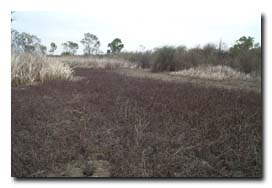Site 30 Two Mile Swamp
Description
Located to the south of Kerang, this is a freshwater marsh that is fed by tributaries of the Loddon River via the Bannaghur Creek during reasonable floods. This Marsh has been dry for a couple of years. Surrounding land uses include cropping and grazing.
Vegetation Description and Composition This Wildlife Reserve is a dry Deep Freshwater Marsh dominated by Muehlenbeckiaflorulenta (Tangled Lignum) with an overstorey of Eucalyptus camaldulensis (Red Gum) and Eucalyptus largiflorens (Black Box) and surrounded by cropping and grazing land. The understorey consists predominantly of introduced grasses, Lolium spp. (Rye-grass), Critesion marinum (Sea Barley Grass), Phalaris paradoxa (Canary-grass) and Polypogon monspeliensis (Annual Beard Grass - none present in late 2002). Members of the Chenopodiaceae family: Atriplex leptocarpa (Slender-fruit Saltbush), Atriplex semibaccala (Berry Saltbush), Einadia nutans (Nodding Saltbush) and Halosarciapergranulata (Blackseed Glasswort) were also abundant. For several years weed species from the Asteraceae family have been abundant, particularly Helminthotheca echioides (Ox-tongue) and Sonchus asper (Prickly Sow Thistle). Fewer than 40% of species present are introduced and their level of abundance has fluctuated over the past six years, due to the drying of the swamp and continued dry seasonal conditions. There are two salt indicator species present, whereas five were recorded last year. Tree health appears stable, but the general appearance of the trees is one of being under stress. Past tree health data appears inconsistent with recently gathered data. Tree regeneration is minimal due to loss of seedlings through grazing by cattle and rabbits. There has been a significant change in vegetation survey results with a continued reduction in species present. However, if seasonally dry seasonal conditions are considered when comparing with previous vegetation data, then this change is understandable. |  Two Mile Swamp |
Water Quality
Two Mile Swamp is a freshwater swamp, with salinity not getting above 2 500 EC. Possible threats to water quality are nutrients derived from upstream landuse activities.
Groundwater and Salinity
Bores are read by Goulburn Murray Water (external link).
Threats to the site continue to be:
- potential rising groundwater and salinity levels.
- weed invasion, particularly introduced pasture species (e.g. Phalaris spp.)
- grazing of regeneration by cattle, rabbits and hares.
Monitoring Survey Dates
December 1997, December 1998, December 1999, December 2000, November 2001, December 2002.


